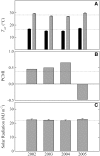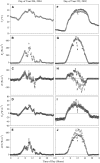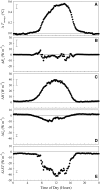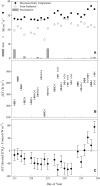Decreases in stomatal conductance of soybean under open-air elevation of [CO2] are closely coupled with decreases in ecosystem evapotranspiration
- PMID: 17114275
- PMCID: PMC1761983
- DOI: 10.1104/pp.106.089557
Decreases in stomatal conductance of soybean under open-air elevation of [CO2] are closely coupled with decreases in ecosystem evapotranspiration
Abstract
Stomatal responses to atmospheric change have been well documented through a range of laboratory- and field-based experiments. Increases in atmospheric concentration of CO(2) ([CO(2)]) have been shown to decrease stomatal conductance (g(s)) for a wide range of species under numerous conditions. Less well understood, however, is the extent to which leaf-level responses translate to changes in ecosystem evapotranspiration (ET). Since many changes at the soil, plant, and canopy microclimate levels may feed back on ET, it is not certain that a decrease in g(s) will decrease ET in rain-fed crops. To examine the scaling of the effect of elevated [CO(2)] on g(s) at the leaf to ecosystem ET, soybean (Glycine max) was grown in field conditions under control (approximately 375 micromol CO(2) mol(-1) air) and elevated [CO(2)] (approximately 550 micromol mol(-1)) using free air CO(2) enrichment. ET was determined from the time of canopy closure to crop senescence using a residual energy balance approach over four growing seasons. Elevated [CO(2)] caused ET to decrease between 9% and 16% depending on year and despite large increases in photosynthesis and seed yield. Ecosystem ET was linked with g(s) of the upper canopy leaves when averaged across the growing seasons, such that a 10% decrease in g(s) results in a 8.6% decrease in ET; this relationship was not altered by growth at elevated [CO(2)]. The findings are consistent with model and historical analyses that suggest that, despite system feedbacks, decreased g(s) of upper canopy leaves at elevated [CO(2)] results in decreased transfer of water vapor to the atmosphere.
Figures







References
-
- Ainsworth EA, Davey PA, Bernacchi CJ, Dermody OC, Heaton EA, Moore DJ, Morgan PB, Naidu SL, Ra HSY, Zhu XG, et al (2002) A meta-analysis of elevated [CO2] effects on soybean (Glycine max) physiology, growth and yield. Glob Change Biol 8 695–709
-
- Ainsworth EA, Long SP (2005) What have we learned from 15 years of free-air CO2 enrichment (FACE)? A meta-analytic review of the responses of photosynthesis, canopy. New Phytol 165 351–371 - PubMed
-
- Ainsworth EA, Rogers A, Nelson R, Long SP (2004) Testing the “source-sink” hypothesis of down-regulation of photosynthesis in elevated [CO2] in the field with single gene substitutions in Glycine max. Agric For Meteorol 122 85–94
-
- Alley RB, Marotzke J, Nordhaus WD, Overpeck JT, Peteet DM, Pielke RA Jr, Pierrehumbert RT, Rhines PB, Stocker TF, Talley LD, et al (2003) Abrupt climate change. Science 299 2005–2010 - PubMed
-
- Arnell N, Liu C (2001) Hydrology and water resources. Climate change 2001: impacts, adaptation, and vulnerability. In JJ McCarthy, OF Canziani, NA Leary, DJ Dokken, KS White, eds, Third Assessment Report of the Intergovernmental Panel on Climate Change. Cambridge University Press, Cambridge, UK, pp 192–236
Publication types
MeSH terms
Substances
LinkOut - more resources
Full Text Sources

